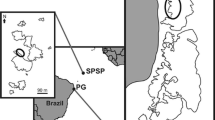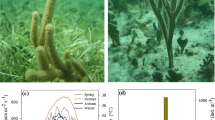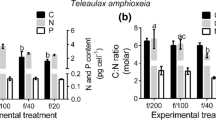Abstract
Adult speciments of the tropical sea anemone Aulactinia stelloides Verrill (McMurrich, 1889) were collected from Andros Island, Bahamas, during October 1983, and the influence of animal developmental stage on the growth and photosynthetic capacity of endosymbiotic algae, as well as the utilization of translocated carbon by the animal, was investigated in adult and juvenile polyps using short-term 14C-bicarbonate labelling experiments. Zooxanthellae cell size was equivalent in adult (A) and juvenile (J) polyps. Light-saturated photosynthetic rates of zooxanthellae in juvenile polyps were double those in adult polyps (J: 5.7±0.2 μg C 106 cells-1 h-1 vs A: 2.4±0.8 μg C 106 cells-1 h-1), as were their cell-division frequencies (J: 4.4±0.5% vs A: 2.2±0.4%). Estimates of the percent of photosynthetically fixed 14C translocated to the anemone tissue by the zooxanthellae during 1 h incubations were lower for juvenile polyps (21%) than for adult polyps (29%). Zooxanthellae carbon-specific, translocation rates were, however, positively correlated with their specific photosynthetic rates. Partitioning of translocated carbon between the methanol-water-soluble, chloroform-soluble, and insoluble fractions of the host tissues exhibited significant variation with the developmental stage of the anemone. A significantly higher proportion of the fixed 14C activity in the animal tissues of adult polyps was recovered from the lipid (33%) compared to the particulate phase (18%). In juvenile polyps, the lipid and particulate fractions had equal proportions (25%) of the animal-tissue 14C activity. This study indicates that host developmental stage can influence zooxanthellae growth rates and consequently the rate of carbon flow within the association. The utilization of translocated carbon by the animal tissue is dependent on the biosynthetic requirements of its developmental stage in addition to its nutritional status.
Similar content being viewed by others
Literature cited
Banse, K.: Cell volumes, maximal growth rates of unicellular algae and ciliates and the role of ciliates in the marine pelagial. Limnol. Oceanogr. 27, 1059–1071, (1982)
Battey, J. F. and J. S. Patton: A reevaluation of the role of glycerol in carbon translocation in zooxanthellae-coelenterate symbiosis. Mar. Biol. 79, 27–38 (1984)
Bertalanffy, L. von: Quantitative laws in metabolism and growth. Q. Rev. Biol. 32, 217–231 (1957)
Biggs, D. C.: Respiration and ammonium excretion by openocean gelatinous zooplankton. Limnol. Oceanogr. 22, 108–117 (1977)
Blanquet, R. S., J. C. Nevenzel and A. A. Benson: Acetate incorporation into the lipids of the anemone Anthopleura elegantissima and its associated zooxanthellae. Mar. Biol. 54, 185–194 (1979)
Bligh, E. G. and W. J. Dyer: A rapid method of total lipid extraction and purification. Can J. Biochem. Physiol. 37, 911–917 (1959)
Brody, S.: Bioenergetics and growth with special reference to the efficiency complex in domestic animals, 1023 pp. New York: Reinhold Publishing Co. 1945
Chang, S. S., B. B. Prézelin and R. K. Trench: Mechanisms of photoadaptation in three strains of the symbiotic dinoflagellate Symbiodinium microadriaticum. Mar. Biol. 76, 219–229 (1983)
Calow, P.: Conversion efficiencies in heterotrophic organisms. Biol. Rev. 52, 385–409 (1977)
Conover, R. J. and E. D. S. Corner: Respiration and nitrogen excretion by some marine zooplankton in relation to their life cycles. J. mar. biol. Ass. U.K. 48, 49–75 (1968)
Cook, C. B.: Metabolic interchange in algae-invertebrate symbiosis. Int. Rev. Cytol. (Suppl.) 14, 177–210 (1983)
Cook, C. B. and M. O. Kelty: Glycogen, protein, and lipid content of green, aposymbiotic, and nonsymbiotic hydra during starvation. J. exp. Zool. 222, 1–10 (1982)
Crossland, C. J. D. J. Barnes and M. A. Borowitzka: Diurnal lipid and mucus production in the staghorn coral Acropora acuminata. Mar. Biol. 60, 81–90 (1980)
Davies, P. S.: The role of zooxanthellae in the nutritional energy requirements of Pocillopora eydouxis. Coral Reefs 2, 181–186 (1984)
Falkowski, P. G., Z. Dubinsky and K. Wyman: Growth-irradiance relationships in phytoplankton. Limnol. Oceanogr. 30, 311–321 (1985)
Fitt, W. K. and R. L. Pardy: Effects of starvation, and light and dark on the energy metabolism of symbiotic and aposymbiotic sea anemones, Anthopleura elegantissima. Mar. Biol. 61, 199–205 (1981)
Fitt, W. K. and R. K. Trench: Spawning, development, and acquisition of zooxanthellae by Tridacna squamosa (Mollusca, Bivalvia). Biol. Bull. mar. biol. Lab., Woods Hole 161 213–235 (1981)
Gieskes, J. M. and W. C. Rogers: Alkalinity determination in interstitial waters of marine sediments. J. sedim. Petrol. 43, 272–277 (1973)
Hartree, E. F.: Determination of protein: a modification of the Lowry method that gives linear photometric response. Analyt. Biochem. 48, 422–427 (1972)
Harvey, H. R. and J. S. Patton: Solvent focusing for rapid and sensitive quantification of total lipids on chromarods. Analyt. Biochem. 116, 312–316 (1981)
Hitchcock, G. L.: Photosynthate partitioning in cultured marine phytoplankton I. Dinoflagellates. J. exp. mar. Biol. Ecol. 69, 21–36 (1983)
Hofmann, D. K. and B. P. Kremer: Carbon metabolism and strobilation in Cassiopea andromedea (Cnidaria: Scyphozoa): significance of endosymbiotic dinoflagellates. Mar. Biol. 65, 25–33 (1981)
Holm-Hansen, O., C. J. Lorenzen, R. W. Holmes and J. D. H. Strickland: Fluorometric determination of chlorophyll. J. Cons. perm. int. Explor. Mer 30, 3–15 (1965)
Johannes, R. E.: Phosphorus excretion and body size in marine animals: microzooplankton and nutrient regeneration. Science, N.Y. 146, 923–924 (1964)
Lewis, D. H. and D. C. Smith: The autotrophic nutrition of symbiotic marine coelenterates with special reference to hermatypic corals. I. Movement of photosynthetic products between the symbionts. Proc. R. Soc. (Ser. B) 178, 111–129 (1971)
Lewis, J. B.: The importance of light and food upon the early growth of the reef coral Favia fragum (Esper). J. exp. mar. Biol. Ecol. 15, 299–304 (1974)
Mague, T. H., E. Friberg, D. J. Hughes and I. Morris: Extracellular release of carbon by marine phytoplankton: a physiological approach. Limnol. Oceanogr. 25, 262–279 (1980)
McCloskey, L. R. and L. Muscatine: Production and respiration in the Red Sea coral Stylophora pistillata as a function of depth. Proc. R. Soc. (Ser. B) 222, 215–230 (1984)
McDuff, R. E. and S. W. Chisholm: The calculation of in situ growth rates of phytoplankton populations from fraction of cells undergoing mitosis: a clarification. Limnol. Oceanogr. 27, 783–788 (1982)
Morris, I.: Photosynthetic products, physiological state and phytoplankton growth. Can. Bull. Fish. aquat. Sciences 210, 83–102 (1981)
Muscatine, L.: Glycerol excretion by symbiotic algae from corals and Tridacna and its control by the host. Science, N.Y. 156, 516–519 (1967)
Muscatine, L. and E. Cernichiari: Assimilation of photosynthetic products of zooxanthellae by a reef coral. Biol. Bull. mar. biol. Lab., Woods Hole 137, 506–523 (1969)
Muscatine, L., P. G. Falkowski and Z. Dubinsky: Carbon budgets in symbiotic associations. In: Endocytobiology, Vol. 2. pp 649–658 Ed. by E. A. Schenk and W. Schwemmler. Berlin: Walter de Gruyter 1983
Muscatine, L., P. G. Falkowski, J. W. Porter and Z. Dubinsky: Fate of photosynthetically fixed carbon in light-and shadeadapted colonies of the symbiotic coral Stylophora pistillata. Proc. R. Soc. (Ser. B) 222, 181–202 (1984)
Muscatine, L. and R. R. Pool: Regulation of numbers of intracellular algae. Proc. R. Soc. (Ser. B) 204, 131–139 (1979)
Muscatine, L., R. R. Pool and E. Cernichiari: Some factors influencing selective release of soluble organic material by zooxanthellae from reef corals. Mar. Biol. 13, 298–308 (1972)
Patton, J. S., S. Abraham and A. A. Benson: Lipogenesis in the intact coral Pocillopora capitata and its isolated zooxanthellae: evidence for a light-driven carbon cycle between symbiont and host. Mar. Biol. 44, 235–247, (1977)
Patton, J. S., J. F. Battey, M. W. Rigler, J. W. Porter, C. C. Black and J. E. Burris: A comparison of the metabolism of bicarbonate 14C and acetate 1-14C and the variability of species lipid composition in reef corals. Mar. Biol. 75, 121–130 (1983)
Phipps, D. W. and R. L. Pardy: Host enhancement of symbiont photosynthesis in the hydra-algae symbiosis. Biol. Bull. mar. biol. Lab., Woods Hole 162, 83–94 (1982)
Rahat, M. and O. Adar: Effect of symbiotic zooxanthellae and temperature on budding and strobilation in Cassiopea andromedea Eschscholtz. Biol. Bull. mar. biol. Lab., Woods Hole 159, 394–401 (1980)
Richmond, R.: Energetic considerations in the dispersal of Pocillopora damicornis (Linnaeus) planulae. Proc. 4th int. Symp. coral Reefs 2, 153–156 (1981). (Ed. by E. D. Gomez et al. Quezon City, Philippines: Marine Sciences Center, University of the Philippines)
Ricker, W. E.: Linear regressions in fishery research. J. Fish. Res. Bd Can. 30, 409–434 (1973)
Schlichter, D.: Nutritional strategies of cnidarians: the absorption, translocation and utilization of dissolved nutrients by Heteroxenia fuscescens. Am. Zool. 22, 659–669 (1982)
Schlichter, D., A. Svoboda and B. P. Kremer: Functional autotrophy of Heteroxenia fuscescens (Anthozoa: Alcyonaria): carbon assimilation and translocation of photosynthates from symbionts to host. Mar. Biol. 78, 29–38 (1983)
Schmitz, K. and B. P. Kremer: Carbon fixation and analysis of assimilates in a coral-dinoflagellate symbiosis. Mar. Biol. 42, 305–313 (1977)
Smith, G. J.: Ontogenetic variation in the symbiotic associations between zooxanthellae (Symbiodinium microadriaticum Freudenthal) and sea anemone (Anthozoa: Actiniaria) hosts, 225 pp. Ph. D. dissertation; University of Georgia, Athens 1984
Smith, R. E. H.: The estimation of phytoplankton production and excretion by carbon-14. Mar. Biol. Lett. 3, 325–334 (1982)
Steen, R. G.: In vivo nuclear magnetic resonance analysis of a symbiotic sea anemone: host bioenergetics and interactions with the symbiont, 142 pp. Ph.D. dissertation, University of California, Los Angeles 1985
Strathmann, R. R.: Estimating the organic carbon content of phytoplankton from cell volume or plasma volume. Limnol Oceanogr. 12, 411–418 (1967)
Strickland, J. D. H. and T. R. Parsons: A practical handbook of seawater analysis, 2nd ed. Bull. Fish. Res. Bd Can. 167, 1–310 (1972)
Szmant-Froelich, A.: Coral nutrition: comparison of the fate of 14C from ingested labeled brine shrimp and from the uptake of NaH14CO3 by its zooxanthellae. J. exp. mar. Biol. Ecol. 55, 133–144 (1981)
Szmant-Froelich, A. and M. E. Q. Pilson: The effects of feeding frequency and symbiosis with zooxanthellae on the biochemical composition of Astrangia danae Milne Edwards and Haime, 1849. J. exp. mar. Biol. Ecol. 48, 85–97 (1980)
Trench, R. K.: The physiology and biochemistry of zooxanthellae symbiotic with marine coelenterates. II. Liberation of fixed 14C by zooxanthellae in vitro. Proc. R. Soc. (Ser. B) 177, 237–250 (1971a)
Trench, R. K.: The physiology and biochemistry of zooxanthellae symbiotic with marine coelenterates. III. The effects of homogenates of host tissues on the extraction of photosynthetic products in vitro by zooxanthellae from two marine coelenterates. Proc. R. Soc. (Ser. B) 177, 251–261 (1971b)
Trench, R. K.: The cell biology of plant-animal symbiosis. A. Rev. Pl. Physiol. 30, 484–531 (1979)
Trench, R. K., N. J. Colley and W. K. Fitt: Recognition phenomena in symbioses between marine invertebrates and “zooxanthellae”; uptake, sequestration and persistence. Ber. dt. bot. Ges. 94, 568–577 (1981)
Vetter, E. F.: The ecology of Penaeus setiferus: habitat selection, carbon and nitrogen metabolism, and simulation modeling, 151 pp. Ph.D. dissertation, University of Georgia, Athens 1983
Von Holt, C. and M. Von Holt: Transfer of photosynthetic products from zooxanthellae to coelenterate hosts. Comp. Biochem. Physiol. 24, 73–81 (1968)
Wilkerson, F. P., G. Muller Parker and L. Muscatine: Temporal patterns of cell division in natural populations of endosymbiotic algae. Limnol. Oceanogr. 28, 1009–1014 (1983)
Zeuthen, E.: Oxygen uptake as related to body size in organisms. Q. Rev. Biol. 28, 1–12 (1953)
Author information
Authors and Affiliations
Additional information
Communicated by R. S. Carney, Moss Landing
Rights and permissions
About this article
Cite this article
Smith, G.J. Ontogenetic influences on carbon flux in Aulactinia stelloides polyps (Anthozoa: Actiniaria) and their endosymbiotic algae. Marine Biology 92, 361–369 (1986). https://doi.org/10.1007/BF00392677
Accepted:
Published:
Issue Date:
DOI: https://doi.org/10.1007/BF00392677




